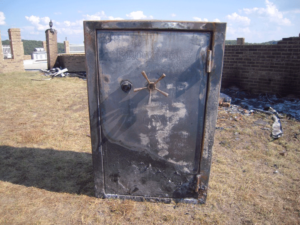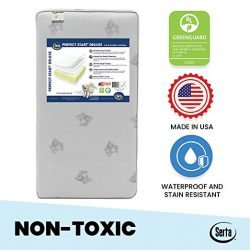A fireproofing might seem unnecessary when you think about safes. There are other things you need to worry about, surely, like saving the furniture or the TV. But you probably already have insurance for that. Gun safes, despite having insurance, can be quite hazardous in fires if they’re not fire-proof.
You’ll be surprised how many risks a gun safe carries in case of a fire hazard. An overheated safe is good as an over. And if your door bends or an edge or corner gives way, the air will carry in oxygen and make your safe into a barbecue, roasting whatever you kept inside for safety. This can cause your stuff to melt, burn or bend out of shape, neither of which are good for guns.
Another potential disaster that can result from a gun in a safe unprepared for fire hazard situations is the bullets heating enough to go off. A hot sheet of metal isn’t always well prepared to handle impact by a bullet that comes flying. You don’t want shrapnel flying around the house while the fire is already ravaging it.
Fireproofing the safe is therefore essential.
Can All Gun Safes Be Fireproofed?

As hard it is to hear, not all safes are really safe when it comes to fires. You’ll be surprised how outdated most safes sold every year really are. The standards of safety we have are perhaps good enough only till the 1950s. Nobody’s going to come to rob a safe with a tiny crowbar and a hammer anymore. There are portable plasma cutters and a ton of other ways to open even the most sturdy looking safes. Needless to say, these safes fare poorer still in the face of a blazing inferno.
Not all gun safes can be fireproofed. The toughest steels turn weaker when faced with a high temperature. Metals as we know are more malleable when they’re hot. A blaze lasting for over an hour can cause a surprising number of safes to fail.
Add to this the fact that fireproofing takes space inside the safe to be properly effective, and the smaller safes might not be very usable either. Then, fitting a safe at a proper location has its advantages. You don’t want a safe that’s too bulky in a small house either, or it’ll be hard to mask.
It won’t be wrong to say that it is better to buy an already fireproofed safe than a simpler safe you can fireproof later. But just in case you’re not open to the idea of buying a new safe, we can tell you how you can fireproof your existing gun safe.
How To Fireproof Your Gun Safe?

Proper fireproofing is hard to accomplish, given how tough it can be to actually account for every way heat and fire can penetrate a system, especially if you have a lot of flammable material like houses often have, be it carpets, wooden floorboards, wallpaper, furniture or other such material. So there is no guarantee of success, but you can always opt for general caution and keeping yourself informed, while following ways to keep flames out like these methods we mention below.
Insulate the safe thoroughly, and then some.
Insulation is crucial in keeping the safe free from heat. People tend to disagree where insulation is best lined, but many prefer keeping it inside the safe because it becomes easier to open the safe as well as to keep heat and air outside.
A few thick sheets of flame retardant insulator material (you can buy them at the hardware shop) can serve well sitting inside a safe. Even if the metal heats up, the material that catches fire, smokes or collapses will still keep things inside safe from heat. Additionally, there are materials that can help prevent air from entering the locked safe as well, which comes in handy as it prevents things inside from smoking up or catching fire, which can be a lifesaver when you’re storing a gun or bullets inside.
Line each surface on the inside of the safe with several layers of insulation. You’re looking to make a box shaped cavity inside the safe that can make sure none of the contents face too much heat in case of a fire. Small safes can have trouble accommodating a lot of layers of insulation. Therefore, it can be better to have a medium or a big safe if this layer of insulation is going to be your primary defence.
Put It Somewhere It Is Hard To Drop
A big component of loss during fires involves structural damage that occurs as material is burned through. Structural damage may also result if the fire heats the material too much instead of outright burning it. Regardless of how the damage occurs, it can make things hard for a safe that has been heating for a possibly long time.

Often safes are mounted on a wall or placed on the floor with wooden floorboards. It is convenient in most situations, but it betrays the purpose of safety which should be the paramount concern when dealing with safes. When fires eat up walls or the flooring, gun safes run the risk of falling down. They’re pretty heavy themselves, and if they’re hot enough, a heavy fall will be enough to make a bolt or two come loose. Safes that are especially weak might even have an entire edge or face give way.
This isn’t dangerous how people usually think it is though. A robber isn’t likely to take advantage of your fire situation and dig through the rubble to look for your safe. Instead it is the air that can get inside the safe from the damage of the drop that should bother you. With air comes oxygen, and chances are temperature is already high in your metal safe. Things you have kept inside are likely to catch fire in such a situation. You don’t want that when your guns are stored inside.
Keep your safe over a concrete floor. Or, hang it securely on a concrete wall, and keep all flammable material away. An architect or engineer should be able to help you which parts of the building are the safest when it comes to structural strength and durability. Or, ask your city’s fire department.
Store Bullets Outside The Gun
This can come off as a bit counter-intuitive, but you don’t want your bullets inside the gun if there is a fire blazing around the safe. Why, you ask? Well, let me briefly delve into the workings of a gun.

Contrary to popular belief, a gun does not rely on fire to send forth your bullets. It is actually the high air pressure generated with the ignition of the gunpowder that propels the bullet through the barrel. The barrel is crucial here. It constricts the pressure and makes sure it is released only in one directions, ie the direction you want to shoot in. The pressure is strong enough to make the bullet break the sound barrier!
Removing the barrel makes the bullet a lot less dangerous, though it is still pretty deadly. The brass (back portion of an unspent bullet) is lighter than the tip that is shot out. When a bullet is ignited without a barrel, the pressure is diffused everywhere, and most of the speed goes to the brass that is lighter in weight.
Storing the bullets outside the barrel in the safe ensures that the gun doesn’t go off due to the high temperature, and the damage is minimal. Also, it is better not to store a lot of bullets, however little impact the shreds of brass may have on the safe’s insides.
Guard Against Rust And Corrosion

Instead of the immediate fire, it can be rust and other such damage that can cause a good part of the damage in a fire hazard. Corroded edges, welds and faces of a safe are its weakest points. A fire will only enhance those weak spots and make them more susceptible to impact or bending.
A lot of corrosion can occur if there is moisture leaking into the environment. It may be a potted plant that’s a tad overwatered, a leaking pipe in the bathroom opposite to the wall, or a roof that’s seeping in water from the thunderstorm. Keeping it in check is fairly simple, so I won’t delve into it in detail.
A less feared cause of corrosion is dust. It might not stand against a swiftly sweeping cloth or duster, but if left unattended, it can cause a lot of corrosion without being spent. With a lot of dust sitting for a long time, metal loses its sheen and becomes bumpy, and it may even lost some strength. This might not be a big concern with a strong safe, but if you have a makeshift quality safe you want to fireproof, this is another thing to watch out for.
Get your safe a decent paint job. Give it a scrub every now and then with a damp cloth, using a dry cloth soon afterwards to prevent any moisture from staying put. Get all leaks and seepages fixed right away.
What If You Have a Wooden Gun Safe?

Fireproofing a wooden gun safe can be tougher, since wood is only too happy to be consumed in an inferno. Fire retardants and insulators can be the first line of defense, but not much else promises safety. Be it a drawer you like to stack your guns in or a cupboard, there is much need to pay attention to fireproofing.
One advantage wood has over metal is that it is an insulator by itself. Even if it is on fire, the part of it not on fire doesn’t get as crazy hot as a sheet of steel that is exposed to an open flame anywhere. Retarding flame, insects like termites and keeping it safe from heavy impact is therefore all you need to take care of.
Like with metal gun safes, keeping the bullets outside the barrels can minimise damage.
Watch out for rot due to leaking water and for termites and other insects too. Drop us any more information you have in the comments below. Want us to write a blog on something you want to learn about? Use the contact page to get in touch with us, or drop us a line below.





